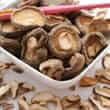Background
- Shiitake mushrooms were originally cultivated on natural oak logs and only grown in Japan but are now available in the United States. These mushrooms are large, black-brown, and have an earthy rich flavor. This fungus is consumed in foods such as stir-fries, soups, and as a meat substitute.
- Shiitake contains proteins, fats, carbohydrates, soluble fiber, vitamins (A, B, B12, C, D, niacin), and minerals. Commercial preparations often use the powdered mycelium of the mushroom before the cap and stem grow. This preparation is called Lentinus edodes mycelium extract (LEM). LEM is rich in polysaccharides and lignans.
- Shiitake has been taken by mouth for boosting the immune system, decreasing cholesterol levels, and for anti-aging. Lentinan, derived from shiitake (Lentinus edodes), has been injected as an adjunct treatment for cancer and HIV infection, although currently high quality human scientific evidence is lacking for many proposed indications. Purified lentinan is considered a drug in Japan.
References
- DeVere White RW, Hackman RM, Soares SE, et al. Effects of a mushroom mycelium extract on the treatment of prostate cancer. Urology 2002;60(4):640-644.
View Abstract - Fujiwara K, Sato T, Yonei T, et al. [A case of chronic hypersensitivity pneumonitis induced by shiitake mushroom spores]. Nihon Kokyuki Gakkai Zasshi 2000;38(12):908-913.
View Abstract - Gordon M, Bihari B, Goosby E, et al. A placebo-controlled trial of the immune modulator, lentinan, in HIV-positive patients: a phase I/II trial. J Med 1998;29(5-6):305-330.
View Abstract - Hanada K, Hashimoto I. Flagellate mushroom (Shiitake) dermatitis and photosensitivity. Dermatology 1998;197(3):255-257.
View Abstract - Hitosugi M, Kitamura O, Takatsu A, et al. Autopsy case of duodenal obstruction from impacted mushroom. J Gastroenterol 1998;33(4):562-565.
View Abstract - Jong SC, Birmingham JM. Medicinal and therapeutic value of the shiitake mushroom. Adv Appl Microbiol 1993;39:153-184.
View Abstract - Lippert U, Martin V, Schwertfeger C, et al. Shiitake dermatitis. Br J Dermatol 2003;148(1):178-179.
View Abstract - Matsui S, Nakazawa T, Umegae Y, et al. Hypersensitivity pneumonitis induced by Shiitake mushroom spores. Intern Med 1992;31(10):1204-1206.
View Abstract - Moore JE, Convery RP, Millar BC, et al. Hypersensitivity pneumonitis associated with mushroom worker's lung: an update on the clinical significance of the importation of exotic mushroom varieties. Int Arch Allergy Immunol 2005;136(1):98-102.
View Abstract - Ng ML, Yap AT. Inhibition of human colon carcinoma development by lentinan from shiitake mushrooms (Lentinus edodes). J Altern Complement Med 2002;8(5):581-589.
View Abstract - Nimura H, Mitsumori N, Takahashi N, et al. [S-1 combined with lentinan in patients with unresectable or recurrent gastric cancer] Gan To Kagaku Ryoho. 2006 Jun;33 Suppl 1:106-9.
View Abstract - Sastre J, Ibanez MD, Lopez M, et al. Respiratory and immunological reactions among Shiitake (Lentinus edodes) mushroom workers. Clin Exp Allergy 1990;20(1):13-19.
View Abstract - Shimada S, Komamura K, Kumagai H, et al. Inhibitory activity of shiitake flavor against platelet aggregation. Biofactors 2004;22(1-4):177-179.
View Abstract - Tarvainen K, Salonen JP, Kanerva L, et al. Allergy and toxicodermia from shiitake mushrooms. J Am Acad Dermatol 1991;24(1):64-66.
View Abstract - Yang P, Liang M, Zhang Y, Shen B. Clinical application of a combination therapy of lentinan, multi-electrode RFA and TACE in HCC. Adv Ther 2008 Aug;25(8):787-94.
View Abstract







